Robert K. Merton’s Strain Theory falls within structural functionalism, which points to the stable or unstable structure of society and its normative ethics as a leading factor in rates of deviance.
According to Strain theorists, deviance within society is a result of the structure of society itself. Merton assumes that all members of society, across all socioeconomic statuses share common values and goals, like being able to own your house, have a car, enjoy holidays, etc.¹
In reality, not everyone is in the same economic or social position to realize these goals. In a society that is not actually meritocratic, there are social groups that do not have an equal opportunity to be successful in these common goals.
In the United States, the ‘American Dream’ is the philosophy that anyone, regardless of background can achieve success if they are willing to work. This idea is operating under the assumption that everyone has equal opportunity.¹ Merton argues that this is not actually true and that the pressure from society to achieve this American Dream pushes individuals to deviance. Essentially, the acquisition of wealth is a dominant cultural goal in the US but legitimate means of achieving this are not uniformly distributed.¹
In Merton’s words, “this social and cultural structure generates pressure for socially deviant behaviour upon people variously located in that structure.”¹ This strain may be either structural or individual. Structural strains are the processes at the societal level that affect someone's perception of their needs. Individual strains are the pains experienced by someone as they look for ways to satisfy their needs.
Merton outline Five Models of Adaptation that people use in response to their strains¹:
- Conformity
- Innovation
- Retreatism
- Ritualism
- Rebellion

Criticisms of Strain Theory include that a lot of crime is not utilitarian but malicious and therefore not applicable under this theory.¹ It also fails to explain youth crimes that people engage in for status instead of acquisition.
Reference:
1. Strain Theory. Retrieved May 8, 2014, from http://socialscience.stow.ac.uk/criminology/criminology_notes/strain_theory.htm
© BrainMass Inc. brainmass.com July 26, 2024, 4:38 am ad1c9bdddf